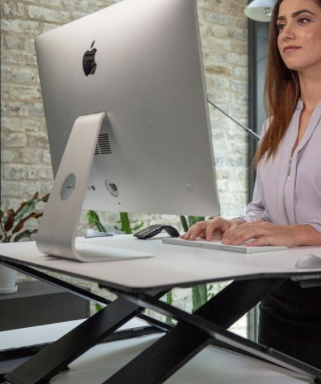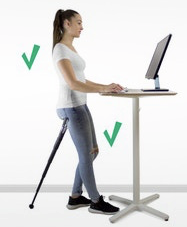A Partial solution.
The Sit-Stand concept slowed following work showing less difference in sitting and standing intra-discal pressures than was first thought. A comeback is occurring as field research has shown the importance of keeping staff exercised and this is increasingly recognised.
Offices could have standing as the default working option with seating as the alternate mode. The 2T (4M version).takes an opposite but complementary approach with the reclined mode being the default and easy ability to stand subsidiary. For a more revolutionary development see next post The end of sitting?
Effect of axial loading on IVD intra-discal pressure
Originally Nachemson and others showed that the standing position had a lower intradiscal pressure than upright sitting. This suggested that incorporating sitting and standing, with a sit-stand desk, could be beneficial if designed into an office environment.
This sit-stand concept has slowed following later work (Wilke 1999) showing less difference in sitting and standing intra-discal pressures and the general recent ergonomic improvement of office chairs.
Effect of movement on the IV disc
The negative consequences of constrained sitting has been described by 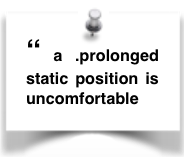 a number of authorities. See ☛ Exercise & movement→. It has been shown that disc nutrition depends on the pumping action of pressure changes due to changes of position and is probably important in avoiding later degenerative changes. In the context of chair design, movement is comforting and avoids the adverse effects of a prolonged constrained static upright mode on general health (See (Lueder R 2002).
a number of authorities. See ☛ Exercise & movement→. It has been shown that disc nutrition depends on the pumping action of pressure changes due to changes of position and is probably important in avoiding later degenerative changes. In the context of chair design, movement is comforting and avoids the adverse effects of a prolonged constrained static upright mode on general health (See (Lueder R 2002).
Variable standing may be ergonomically superior to the prolonged use of existing upright chairs. See ☛ BIOMECHANICS that determine safe sitting→). The sit-stand concept can be said to side-step the issue of the high prevalence of spinal disorders with conventional office chairs. Also relevant is a report by The UK DoH (Dept. of Health, Dept of Children, Schools & Families.) on ‘Sedentary Behaviour and Obesity: Review of the Current Scientific Evidence’.→ https://assets.publishing.service.gov.uk/government/uploads/system/uploads/attachment_data/file/213745/dh_128225.pdf
But, on the other hand, prolonged standing is tiring and affects venous return. Most people prefer sitting, because it is energy efficient with less action by the Erector Spinae & leg muscles than when standing. Having spent many hours in operating theatres, I am perhaps somewhat biased against prolonged standing. HAS.
The design of recent showpiece offices emphasise large attractive space where staff can socialise, discus innovation and shown looking happy. Of fundamental importance, but often neglected, being an indoor environment the adverse factors shown in OFFICE HEALTH, Stress & Ergonomics cannot be ignored if optimum productivity is required.
Sit-Stand.Com is official supplier to the Get Britain Standing campaign. For summary guidance please visit: Benefits of Standing They say Sit-stand desks (commonly referred to as “standing desks”) are increasingly expected to become the norm in the near future. Already in Scandinavia 90% of office workers enjoy the health benefits of sit-stand desks largely driven by workplace health legislation.
Not all office work is suitable for a Sit-Stand system and prolonged sitting may be required. A 2T (3M) chair is essential and preferably the 4M workstation. 2T CONCEPT a full solution→
Back to the Future
Oddly, the Sit-Stand concept has similarities to the Victorian office. For a light hearted account see ☛ HAS, on ☛ Office health (& RSI)→
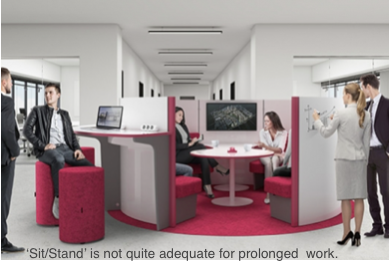
For an example by RAAAF (Rietveld Architecture-Art-Affordances) , See ☛ The end of sitting? →
Office-based’ studies
The first known ‘office-based’ study in the Department of Clinical Sciences and Nutrition, at the University of Chester, Chester, UK, 2016, compared two days of continuous monitored capillary blood glucose responses to sitting and standing in normally desk-based workers. The results provided encouraging signs of attenuating post-prandial glycaemic excursion and why avoiding continuous sitting at work could benefit cardio-metabolic health. The following articles are referenced:-
- Prologed standing is tiring and affects venous return and can adversely affect body and cognitive abilities. – Are Standing Desks The Biggest Sham Ever?→ Wilmot EG, Edwardson CL, Achana FA, et al. Sedentary time in adults and the association with diabetes, cardiovascular disease and death: systematic review and meta-analysis. Diabetologia 2012;55:2895–905.
- Saunders TJ, Larouche R, Colley RC, et al. Acute sedentary behaviour and markers of cardiometabolic risk: a systematic review of intervention studies. J Nutr Metab 2012;2012:712435.
- Gennuso KP, Gangnon RE, Matthews CE, et al. Sedentary behavior, physical activity, and markers of health in older adults. Med Sci Sports Exerc 2013;45:1493–500.
- Leon-Munoz LM, Martinez-Gomez D, Balboa-Castillo T, et al. Continued sedentariness, change in sitting time, and mortality in older adults. Med Sci Sports Exerc 2013;45:1501–7.
- Levine JA, Schleusner SJ, Jensen MD. Energy expenditure of nonexercise activity. Am J Clin Nutr 2000;72:1451–4.
- Koepp GA, Manohar CU, McCrady-Spitzer SK, et al. Treadmill desks: a 1-year prospective trial. Obesity 2013;21:705–11.
- Peddie MC, Bone JL, Rehrer NJ, et al. Breaking prolonged sitting reduces postprandial glycemia in healthy, normal-weight adults: a randomized crossover trial. Am J Clin Nutr 2013;98:358–66.
- Pescatello LS, Arena R, Riebe D, et al. (Eds). ACSM’s Guidelines for exercise testing and prescription. Baltimore: Lippincott, Williams and Wilkins, 2013.
- Speck RM, Schmitz KH. Energy expenditure comparison: a pilot study of standing instead of sitting at work for obesity prevention. Prev Med 2011;52:283–4.
- Blaak EE, Antoine JM, Benton D, et al. Impact of postprandial glycaemia on health and prevention of disease. Obesity Rev 2012;13:923–84.
 Service FJ. Glucose variability. Diabetes 2013;62:1398–404.
Service FJ. Glucose variability. Diabetes 2013;62:1398–404.- Satya Krishna SV, Kota SK, Modi KD. Glycemic variability: clinical implications. Indian J Endocrinol Metab 2013;17:611–19. A number of bio-mechanically efficient stools have been produced which usually incorporate a FTS, contouring and sometimes iliac support.
- Paul Matthews, from Office Fitness Ltd.point out that sleeping burns 59 calories an hour, sitting about 60 calories and standing about 80 to 90 calories. Office workforce should do low activity for 5 hours a day.
- The Journal of Sports Medicine in 2015 published research suggesting standing for two hours spread out in a typical working day.
- The Mayo Clinic suggests getting up for 10 minutes out of every hour.
- The negative consequences of constrained sitting has been described by a number of authorities (Adams and Hutton, 1983; Duncan and Ferguson, 1974; Edlund, There are advantages in keeping staff moving around and inter-reacting in certain types of office. Note that a sit/stand system can always incorporated into a 3M work chair station→
Sit-Stand desks

Offered by the Market is often little more than an upright office chair or stool and a variable height table as shown by the Albion range.
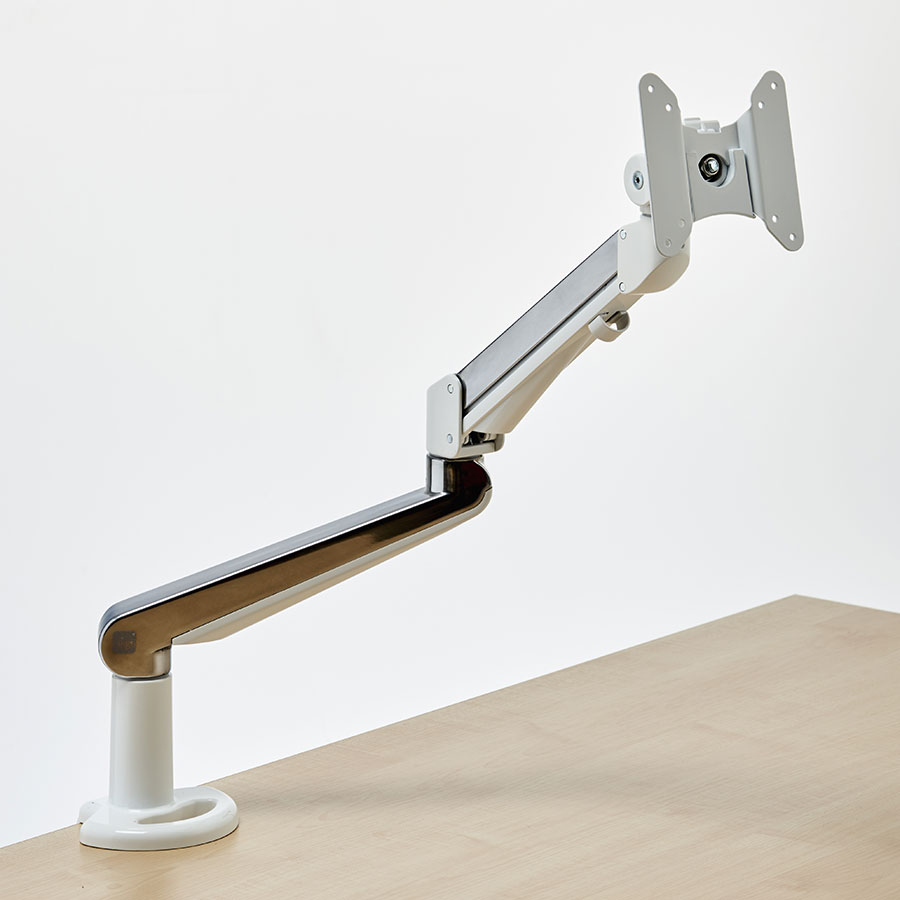 Improvements include components which could be used in the 4M or 3M Workstation. Shown is another Albion example. http://albionchairs.com/office-chairs-by-application.htm
Improvements include components which could be used in the 4M or 3M Workstation. Shown is another Albion example. http://albionchairs.com/office-chairs-by-application.htm
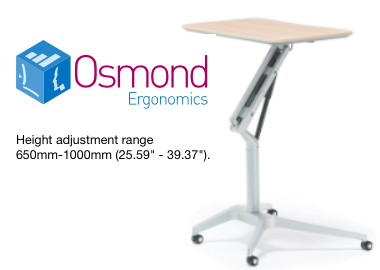 The Osmond is a minimalist variable height desk.
The Osmond is a minimalist variable height desk.
For a more sophisticated solution, a ‘stand’ mode can be incorporated into the a 3M ‘desk-less’ workstation which then becomes a 4M concept (and a ‘full’ solution ). This extra mode results in the first change since the inception of the 2T concept in 1998. (See ☛workstations→).
Stools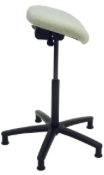
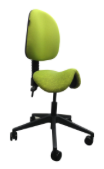 Albion, once again, have a number of simple good stools.
Albion, once again, have a number of simple good stools.
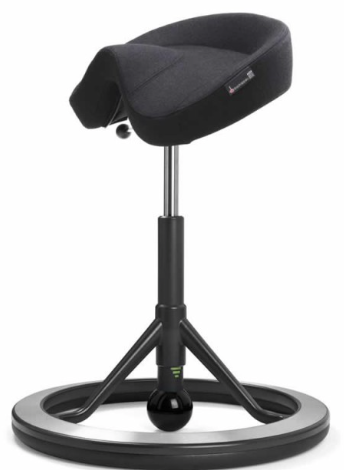
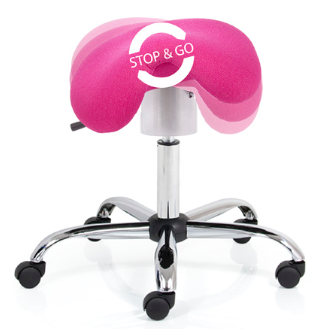 ☜ The Pesko ERGO FLEX M 1_1 also incorporates a ‘wobble”.
☜ The Pesko ERGO FLEX M 1_1 also incorporates a ‘wobble”.
A recent, more complex example is the Freedman chair in which the 2 halves of the seat can move independently, intending to accommodate spinal irregularity (scoliosis) and pelvic side tilting. The emphasis is on the FTS concept and movement.☟
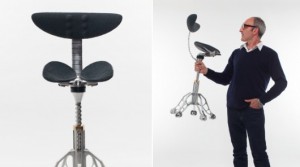 Apparently the model succumbed to a mechanical failure. https://www.kickstarter.com/projects/929020713/the-freedman-chair-a-better-way-to-sit
Apparently the model succumbed to a mechanical failure. https://www.kickstarter.com/projects/929020713/the-freedman-chair-a-better-way-to-sit
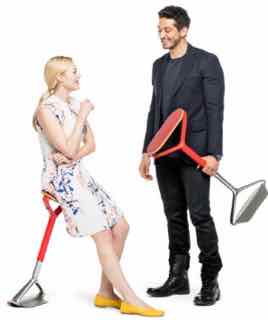 The HiLo
The HiLo
by Box Clever 2016, an innovation agency led by industrial designers Bret Recor and Seth Murray for Knoll Knoll produce a number of high end task chairs with semi-remediation such as pelvic support but have not yet made the jump into a fully remediated chair.
It seems to be an indoor version of the old ‘Shooting sticks’ that I used to use. Very sensible. (→ https://www.knoll.com/search-results?searchtext=HiLo&parent=1347382605724 )
“The new Sitpack ZEN is the world’s most compact, and functional seating designed to improve your posture, whether you’re indoors or outdoors ..

